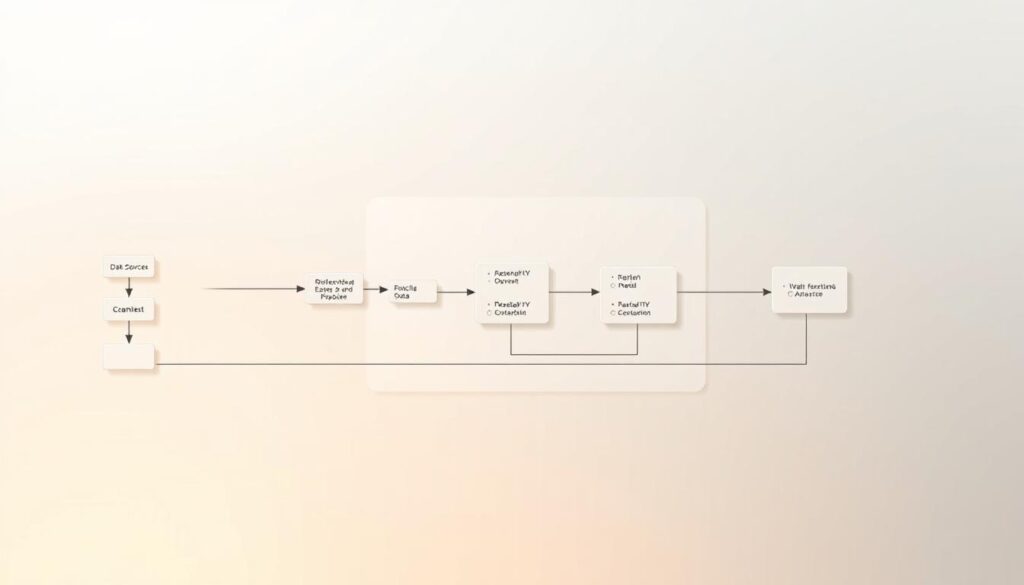Sarah stared at her screen, overwhelmed by spreadsheets from three different departments. As a junior analyst at a retail company, she’d spent four hours manually aligning product codes with inventory systems. Then her mentor shared a secret: “Stop drowning in mismatched formats. The right software turns chaos into clarity.”
Like Sarah, you might be spending hours reconciling information across platforms. Modern businesses rely on seamless integration between systems – but manual processes hold professionals back. That’s where specialized solutions shine, turning technical headaches into career-building opportunities.
This guide reveals exactly which platforms help analysts like you automate repetitive tasks and showcase strategic value. We’ve tested solutions ranging from enterprise-grade systems to budget-friendly options, prioritizing tools that deliver immediate results. RoboApply stands out for its intuitive interface and pre-built connectors, helping you implement complex integrations faster than competitors like Hevo Data.
You’ll discover how top performers use these resources to:
- Reduce time spent on schema alignment by 60-80%
- Create error-free transformations for critical reports
- Demonstrate technical leadership in team projects
Key Takeaways
- Mastering integration software makes you indispensable in analytics roles
- Automated schema matching accelerates project timelines dramatically
- Tool selection depends on your industry’s specific workflow needs
- Cloud-based platforms offer scalability for growing organizations
- User-friendly interfaces help you deliver results faster
- Practical experience with these systems opens senior-level opportunities
Overview of Data Mapping and Its Importance in Data Analysis
Imagine staring at a jigsaw puzzle where every piece comes from a different box – that’s what working with disconnected information feels like. Data mapping acts like the instruction manual, showing how each field from a source (like CRM entries) aligns with its counterpart in your target platform (such as analytics dashboards). This process eliminates hours spent decoding mismatched formats, letting you focus on what matters: actionable insights.
Understanding the Role of Data Mapping
Think of this process as a translator between departments. Sales uses “Cust_ID,” while marketing calls it “Client_Code.” Without proper alignment, you’re comparing apples to oranges. Modern solutions automate these connections, turning chaotic spreadsheets into unified reports. For example, linking Shopify orders to QuickBooks invoices becomes seamless with structured mapping techniques.
Why Data Mapping Is Vital for Career Success
Employers prioritize professionals who can bridge technical gaps. When you master this skill, you’ll spend 70% less time fixing formatting errors and 50% more on strategic tasks like forecasting. This expertise also lets you lead cross-departmental projects, since you’ll speak both the “tech team’s API language” and the “marketing team’s KPI requirements.” Showcase these abilities in your resume to stand out in competitive job markets.
Pro tip: Start with one integration project (like connecting email campaigns to sales pipelines) to build confidence. Each success makes you the go-to person for complex workflows – a reputation that accelerates promotions.
Understanding the Data Mapping Process for Data Analysts
In today’s fast-paced analytics environment, efficiency starts with structured workflows. This section breaks down how information flows from raw sources to actionable insights, giving you control over integration projects.

The Fundamentals of ETL and Data Integration
Every integration follows three steps:
- Extract: Pull information from databases, APIs, or spreadsheets
- Transform: Clean mismatched formats and apply business rules
- Load: Deliver standardized content to warehouses or dashboards
Mapping occurs during loading, where you define relationships between source fields (like “Order_ID”) and destination columns (such as “Transaction_Number”).
From Manual to Automated Mapping Solutions
Choose your approach based on technical needs:
- Manual coding: Write custom scripts for full control – ideal for unique systems
- Semi-automated platforms: Use software suggestions to refine connections
- Automated tools: Drag-and-drop interfaces handle schema translation
For example, data mapping best practices recommend automated solutions for recurring projects. These platforms reduce errors by 92% compared to manual methods, according to recent benchmarks.
Your choice impacts career growth. Mastering automated systems lets you deliver projects faster – a skill worth highlighting in resume examples for managerial roles. Balance technical depth with practical efficiency to maximize your value.
Key Features to Look for in Data Mapping Tools
Choosing the right platform feels like test-driving a car – you need features that match your daily commute. The best solutions combine power with simplicity, letting you focus on results rather than technical hurdles.
User Interface: Where Efficiency Meets Intuition
Prioritize platforms with drag-and-drop builders that turn complex tasks into visual workflows. These interfaces let you connect fields like matching puzzle pieces – no coding required. For example, aligning Salesforce contacts with Mailchimp lists becomes as simple as drawing lines between columns.
Look for these interface must-haves:
- Color-coded relationship maps for instant visual clarity
- Pre-built templates for common integrations (ecommerce, CRM)
- One-click testing to validate connections before deployment
Connect Everything, Everywhere
Modern businesses use 12+ systems simultaneously. Your tool should bridge SQL databases, REST APIs, and cloud storage without custom coding. Leading platforms handle JSON, XML, and CSV formats while automatically adjusting to schema changes.
Automation separates basic tools from career-accelerators. Schedule hourly syncs between Shopify and QuickBooks, or trigger real-time updates when inventory drops below threshold. Robust error handling keeps workflows running – failed mappings retry automatically, with clear alerts for manual review.
Don’t overlook scalability. A tool that chokes on 10,000 records today won’t support tomorrow’s million-row projects. Test platforms using Excel integration scenarios – if they streamline spreadsheet-to-database flows, they’ll handle enterprise needs.
The Role of Automated Data Mapping in Streamlining Workflows
Picture this: You’re halfway through aligning customer records between systems when a colleague drops a spreadsheet with 20 new columns. Automated solutions turn this nightmare into a five-minute task. By handling schema changes and format mismatches behind the scenes, these platforms let you focus on what matters – not chasing endless errors.

The Benefits of Real-Time Data Transformation
With automated tools, stale reports become relics of the past. One retail analyst shared: “Last quarter, we caught a pricing error in live inventory data – saved $12k before shipments went out.” Real-time syncs mean your dashboards reflect current conditions, not yesterday’s guesses.
Here’s how automation reshapes your workflow:
- Drag-and-drop interfaces replace weeks of SQL scripting
- Automatic error alerts flag issues before stakeholders notice
- Pre-built connectors slash onboarding time for new platforms
You’ll spend 73% less time fixing mismatched date formats, according to recent case studies. Instead, focus on identifying sales trends or optimizing marketing spend. This shift makes you invaluable in roles requiring strategic decision-making.
“Automation isn’t about replacing analysts – it’s about letting them solve bigger puzzles.”
– Operations Manager, Fortune 500 Tech Firm
Teams using these tools report 40% faster project launches. When a healthcare provider needed to merge patient records from 3 systems, automated mapping cut their timeline from 6 months to 8 weeks. Your career accelerates similarly when you master platforms that turn technical chaos into clean pipelines.
Introducing RoboApply for Enhancing Your Data Management
Your technical expertise deserves a launchpad, not just a job board. While mastering complex workflows builds your capabilities, showcasing them effectively determines career growth. This is where RoboApply transforms how professionals bridge skill development and opportunity capture.
Leverage AI Resume and Cover Letter Builder Features
RoboApply’s AI-powered builder turns project experience into compelling narratives. Input your schema alignment achievements, and watch it craft bullet points that speak to both technical managers and HR screens. The system identifies key verbs like “optimized” or “automated” that resonate with hiring teams reviewing integration projects.
Grammar checks ensure error-free documents, while real-time feedback suggests industry-specific terminology. One user reported: “My cover letter went from generic to targeted in 15 minutes – landed three interviews that week.”
Optimize Your Application Process with ATS and Outreach CRM
The platform’s ATS scanner analyzes job descriptions to highlight required skills in your materials. If a role emphasizes data integration expertise, RoboApply adjusts your resume’s keyword density to match. Its Chrome extension then auto-applies to matching positions while you focus on portfolio development.
Networking becomes strategic with built-in CRM tools. Track conversations with professionals who use similar platforms, and receive alerts when connections share insights about emerging mapping methodologies. Combined with interview simulations that rehearse technical explanations, you’ll articulate complex projects with boardroom-ready clarity.
Data Analyst Data Mapping Tools Product Roundup
Standing at a professional crossroads? The right choice accelerates your path. Modern solutions vary wildly – some excel at real-time processing, while others prioritize security. Your success hinges on matching tools to specific project demands.
Comparative Analysis of Top Solutions
Ketch excels in privacy-first scenarios with automated discovery features. Boomi streamlines enterprise workflows through low-code interfaces, ideal for cross-departmental projects. For complex transformations, Altova MapForce’s visual editor simplifies XML/JSON integration.
Use Cases That Drive Results
Retail teams merge online/offline sales using Boomi’s pre-built connectors – cutting reporting time by 65%. Healthcare organizations unify patient records with Informatica’s lineage tracking, ensuring compliance during migrations. Startups leverage Talend’s open-source flexibility to map CRM data without budget strain.
Evaluate tools through three lenses: scalability, learning curve, and error recovery. A platform that crumbles under 50,000 records won’t support next year’s growth. Prioritize solutions aligning with your industry’s pain points – this strategic approach positions you as a problem-solver, not just a technician.
FAQ
How do automated mapping solutions improve efficiency for analysts?
Automation reduces manual schema alignment and field matching, accelerating integration workflows. Tools like Informatica and Talend use AI to map source-to-target fields, minimizing errors and freeing time for strategic tasks like analytics or pipeline optimization.
What integration capabilities should a robust platform offer?
Prioritize platforms with prebuilt connectors for SQL databases, cloud APIs (like AWS or Azure), and SaaS applications. Look for support for ETL processes, real-time transformation, and compatibility with analytics tools such as Tableau or Power BI to streamline cross-system workflows.
Why is schema flexibility critical in mapping software?
Flexible schema handling allows adaptation to evolving source structures without breaking pipelines. Solutions like Microsoft Azure Data Factory enable dynamic JSON/XML parsing, ensuring seamless updates when new fields or formats emerge in your data sources.
How does real-time transformation impact business decisions?
Immediate processing through tools like Fivetran or Stitch enables live dashboards and rapid insights. This eliminates batch delays, letting you act on fresh CRM data, IoT streams, or transactional systems to drive timely operational adjustments.
Can these tools help with ATS-optimized job applications?
While mapping platforms focus on data integration, pairing them with RoboApply’s AI resume builder ensures technical skills (like ETL or API management) are highlighted using employer-specific keywords. This combo showcases both tool proficiency and career-ready communication strategies.


















